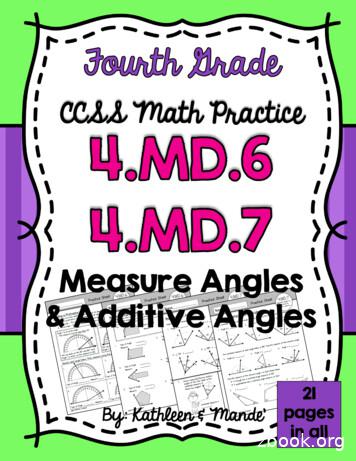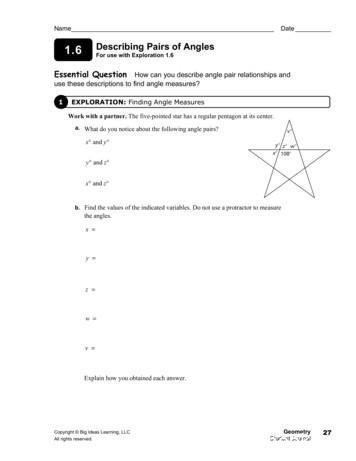Sec. 1.2 Angles And Angle Measure 11 Section 1.2 Angles .
Sec. 1.2 Angles and Angle Measure11Section 1.2 Angles and Angle MeasureCLASSIFICATION OF ANGLES1.Right angles are angles whichmeasure 90 .2.Straight angles are angles which measure180 . Every line forms a straight angle.180 C90 B3.ABAAcute angles are angles which havea (positive) measure less than 90 .4.CObtuse angles are angles which measuregreater than 90 and less than 180 .AB45 B150 ACADJACENT ANGLES5.Adjacent angles are any two angles that share a commonside, forming an even larger angle; all three angles, ABD, DBC, and ABC, have the same vertex, andthe shared side must be in the interior of the larger angle.DABCAll of the points on the ray BD (except the endpoint, B) are in the interior of the larger angle ABC. Inthis case, we can say that ABD and DBC are adjacent angles. Together, they form the larger angle, ABC.In fact, the measure of the larger angle is the sum of the measures of the two smaller angles:m ABC m ABD m DBC.Likewise, the measure of one of the smaller angles is the difference between the measure of the largestangle and the measure of the other smaller angle:m DBC m ABC – m ABD.Sec. 1.2 Angles and Angle Measure11 Robert H. Prior, 2016Copying is prohibited.
12Example 1:Answer:Sec. 1.2 Angles and Angle MeasureGiven the diagram below, find m ABC giventhe measures of ABD and DBC.a)m ABD 80 and m DBC 45 b)m ABD 85 39’ 51” andm DBC 51 24’ 26”a)m ABC 80 45 125 b)m ABC 85 39’ 51” 51 24’ 26”136 63’ 77”Answer:BCUse m ABC m ABD m DBC85 39’ 51” 51 24’ 26”Example 2:DAAdjust the seconds, then the minutes, to where theyare both less than 60: 136 64’ 17” 137 04’ 17”Given the diagram below, find m DBC giventhe measures of ABC and ABD.a)m ABC 140 and m ABD 85 b)m ABC 128 39’ 12” andm ABD 53 45’ 31”DABCUse m DBC m ABC – m ABDa)m DBC 140 – 85 55 b)m DBC m ABC – m ABDm DBC 128 39’ 12” – 53 45’ 31”Notice that the minutes and seconds change as we borrow:Make 1’ into 60”128 39’ 12”– 53 45’ 31” Make 1 into 60’128 38’ 72”– 53 45’ 31” Now subtract127 98’ 72”– 53 45’ 31”m DBC 74 53’ 41”Sec. 1.2 Angles and Angle Measure12 Robert H. Prior, 2016Copying is prohibited.
Sec. 1.2 Angles and Angle Measure13SUPPLEMENTARY AND COMPLEMENTARY ANGLES6.Supplementary angles are any two angles with measures that add to 180 . Supplementary anglescan be adjacent, but they don’t have to be.DD135 45 BAZ135 45 CBAWe say that ABD and DBC are supplementary.We also say that DBC is the supplement of ABD,and vice-versa.YX XYZ is the supplement of DBA.m ABD m DBC 180 m ABD m XYZ 180 m DBC 180 – m ABD.m XYZ 180 – m ABD.Example 3: ABC and XYZ are supplementary angles. Given m ABC, find m XYZ.a)Answer:m ABC 140 b)m ABC 54 28’ 15”Use m XYZ 180 – m ABCa)m XYZ 180 – 140 40 b)m XYZ 180 – 54 28’ 15”Make 1 into 60’180 00’ 00”– 54 28’ 15”Make 1’ into 60” 179 60’ 00”Now subtract 179 59’ 60”– 54 28’ 15”– 54 28’ 15”m XYZ 125 31’ 45”DAngles that are both adjacent and supplementaryform a straight angle, a line:m ABC 180 Sec. 1.2 Angles and Angle MeasureA13BC Robert H. Prior, 2016Copying is prohibited.
14Sec. 1.2 Angles and Angle Measure7.Complementary angles are any two angles with measures that add to 90 . Complementary anglescan be adjacent, but they don’t have to be.C55 BCD55 35 35 ZLikewise, XYZ is the complement of DBC. ABC and XYZ are complementary angles. Given m ABC, find m XYZa)Answer:XYBAWe can say that ABD and DBC arecomplementary, or that DBC is thecomplement of ABD.Example 4:Dm ABC 53 b)m ABC 54 28’ 15”Use m XYZ 90 – m ABCa)m XYZ 90 – 53 37 b)m XYZ 90 – 54 28’ 15”Make 1 into 60’90 00’ 00”– 54 28’ 15” Make 1’ into 60”89 60’ 00”– 54 28’ 15” Now subtract89 59’ 60”– 54 28’ 15”m XYZ 35 31’ 45”In Section 1.3 we discuss triangles and prove that the sum of the three angles in a triangle is 180 . Atthis point though, we will assume that to be true for the purposes of this next, brief discussion:In a right triangle (a triangle with one right angle), the two acute angles arecomplementary. This is easy to demonstrate:Bm C m A m B 180 90 m A m B 180 m A m B 90 CASo, A and B are complementary.Sec. 1.2 Angles and Angle Measure14 Robert H. Prior, 2016Copying is prohibited.
Sec. 1.2 Angles and Angle Measure15ANGLE BISECTORSAn angle bisector splits an angle into two smaller,congruent angles.ASaid more formally, an angle bisector is a ray thatbegins at the angle’s vertex and passes through aninterior point so that it forms two smaller,congruent angles.Example 5:Answer:ADBCBCRay BD bisects ABC. Given the measure of ABC, find the measure of DBC.Write answers in DMS form.a)m ABC 48 b)m ABC 53 c)m ABC 65 43’ 10”d)m ABC 72 28’ 31”Use m DBC m ABC 2a)m DBC 48 2 24 b)m DBC 53 2. 53 is an odd number, but we can make it even byborrowing 1 from it and making m ABC 52 60’. These are both divisibleby 2:m DBC 53 2 (52 60’) 2 26 30’c)m DBC 65 43’ 10” 2. Both 65 and 43 are odd numbers, but wecan make them even by borrowing 1 degree (or minute) from each to makethem both even:65 43’ 10” 64 103’ 10” 64 102’ 70”We can now easily divide each of these by 2:m DBC (64 102’ 70”) 2 32 51’ 35”.d)The number of seconds is odd, 31, and there is nothing that will make iteven. Because the other values are already even, we can divide as follows:m DBC (72 28’ 31”) 2 36 14’ 15.5”.Sec. 1.2 Angles and Angle Measure15 Robert H. Prior, 2016Copying is prohibited.
16Sec. 1.2 Angles and Angle MeasureVERTICAL ANGLESWhen two lines intersect in a plane, several pairs of angles areformed: Adjacent angles are supplementary (forming a straight line)and non-adjacent angles are vertical angles. It can easily beshown that vertical angles are congruent to each other:130 4Given: m 2 130 3130 21344130 21213250 150 4 3 is supplementary to 2 som 3 180 – 130 50 .350 Likewise, 1 is supplementaryto 2, so m 1 is also 50 .Therefore, m 1 m 3, and 1 3.It follows that m 4 is also 130 . 4 is vertical to 2, and 4 2.Example 6:In the diagram of intersecting lines, given m 1 27 , find the measures of the otherthree angles.Answer:m 3 m 1 anda) 2 and 4 are both supplementary to 1, so,m 3 27 b)c)m 2 180 – 27 153 m 4 153 .PERPENDICULAR LINES AND LINE SEGMENTSTwo lines in a plane that intersect to form four right angles are said to be perpendicular. If two lines orline segments, AB and CD , are perpendicular, then we may write AB CD .CCBADDASec. 1.2 Angles and Angle MeasureCBA16DB Robert H. Prior, 2016Copying is prohibited.
Sec. 1.2 Angles and Angle Measure17PARALLEL LINES AND TRANSVERSALSTwo lines in a plane, line1 and line2, are parallel if they never intersect. We sometimes use arrowsgoing in the same direction to indicate that two lines (or line segments) are parallel to each other.line1line1line2line2A line that intersects two (or more) parallel lines is called atransversal. The transversal and the parallel lines form atotal of eight angles.There are many pairs of congruent angles and many pairs ofsupplementary angles.tline 1line 21 23 45 67 8transversalIf the transversal is not perpendicular to the parallel lines, then four acute angles and four obtuse anglesformed. This leads us to the following:(i)all of the acute angles are congruent to each other and all of the obtuse angles arecongruent to each other;(ii)each acute angle is supplementary to each obtuse angle.To talk about these eight angles easily, we refer to them in this way (fill in the blanks):(i)left side of transversal:tline 1(ii) right side of transversal:line 21 23 45 67 8transversal(iii) directly above a parallel line:(iv) directly below a parallel line:(v) interior angles:(vi) exterior angles:Sec. 1.2 Angles and Angle Measure17 Robert H. Prior, 2016Copying is prohibited.
18Sec. 1.2 Angles and Angle MeasureIn this setting, a pair of corresponding angles are angles thatare on the same side of the transversal (left or right) and areeither both above or both below the parallel lines.For example, 1 and 5 are a pair of corresponding anglesbecause they are both to the above-left angles.tcorresponding angles1line1line25Corresponding angles are congruent.Alternate interior angles are on opposite sides of thetransversal (one on the left, one on the right) and are “between”the parallel lines: below line1 and above line2.For example, 4 and 5 are alternate interior angles.talternate interior anglesline1line245Alternate interior angles are congruent.Alternate exterior angles are on opposite sides of thetransversal (one on the left, one on the right) and are outside ofthe parallel lines: above line1 and below line2.For example, 1 and 8 are alternate interior angles.talternate exterior angles1line1line28Alternate exterior angles are congruent.As we already know, all of the vertical angles are congruent; for example 1 4 and 6 7.Also, all of the adjacent angles form lines (straight angles), so each pair of adjacent angles issupplementary.Sec. 1.2 Angles and Angle Measure18 Robert H. Prior, 2016Copying is prohibited.
non-adjacent angles are vertical angles. It can easily be . all of the acute angles are congruent to each other and all of the obtuse angles are congruent to each other; (ii) each acute angle is supplementary to each obtuse angle. To talk about these eight angles e
rope High Knee Jog Push ups Over head Slam Dips Kettle Bell Swing Goblet Squat Split Jump Mountain Climbers Alt Lunge Crunches Plank Reverse Curl Cycle Legs Warm up: Rowing Machine 500 meters 20 sec 20 sec 20 sec 20 sec 20 sec 20 sec 20 sec 20 sec 20 sec 20 sec 20 sec 20 sec 20 sec 20 sec 20 sec 20 sec Stop watch required. Complete each
Calf Raise - standing or seated 12 reps 60 sec 10 reps 60 sec 8 reps 60 sec 6 reps 60 sec CORE Crunches 20 reps 30 sec 20 reps 30 sec 20 reps 30 sec Plank 60 sec 30 sec 60 sec 30 sec 60 sec 30 sec Plate Twist 20 reps 30 sec 20 reps 30 sec 20 reps 30 sec THE WAY TO BULK
- Page 8 Measuring Angles: Real-Life Objects - Page 9 Draw Angles - Page 10 Draw Angles: More Practice - Page 11 Put It All Together: Measure & Draw Angles - Page 12 Joining Angles - Page 13 Joining More Than Two Angles - Page 14 More Practice: Joining Angles - Page 15 Separating Angles .
Adjacent angles are two angles that share a common vertex and side, but have no common interior points. 5 and 6 are adjacent angles 7 and 8 are nonadjacent angles. Notes: Linear Pairs and Vertical Angles Two adjacent angles are a linear pair when Two angles are vertical angles when their noncommon sides are opposite rays.
cycle time 1/(ops/sec) required sec/op equipment capability actual sec/op actual sec/op required sec/op - happiness required sec/op actual sec/op - misery (or multiple resources) Typical cycle times: 3-5 sec manual small parts 5-10 sec small robot 1-4 sec small fixed automation 10-60 sec large robot or manual large parts
vertical angles. Vertical angles have the same measure. Vertical angles are also called opposite angles. 1 and 2 are vertical angles. 3 and 4 are vertical angles. 14. In this triangle, name a pair of complementary angles. m T 30 m L 60 30 60 90 . So T and L are complementary angles. 15. In this parallelogram, name a pair of .
Vertical Angles Words Two angles are vertical angles if they are opposite angles formed by the intersection of two lines. Vertical angles are congruent. Examples 4 2 3 1 1 and 3 are vertical angles. 2 and 4 are vertical angles. EXAMPLE 2 Finding Angle Measures Find the value of x. a. 70 x The
Adjacent Angles: Two angles and with a common side ⃗⃗⃗⃗⃗ are adjacent angles if belongs to the interior of . Vertical Angles: Two angles are vertical angles (or vertically opposite angles) if their sides form two pairs of opposite rays. Angles on a Line: The sum of the me























